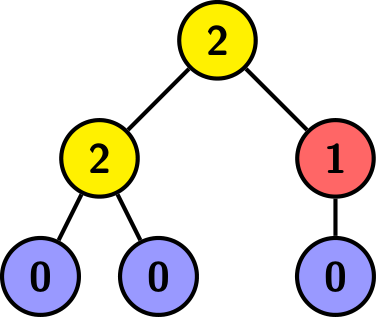311213: CF1950F. 0, 1, 2, Tree!
Description
Find the minimum height of a rooted tree$^{\dagger}$ with $a+b+c$ vertices that satisfies the following conditions:
- $a$ vertices have exactly $2$ children,
- $b$ vertices have exactly $1$ child, and
- $c$ vertices have exactly $0$ children.

The tree above is rooted at the top vertex, and each vertex is labeled with the number of children it has. Here $a=2$, $b=1$, $c=3$, and the height is $2$.
$^{\dagger}$ A rooted tree is a connected graph without cycles, with a special vertex called the root. In a rooted tree, among any two vertices connected by an edge, one vertex is a parent (the one closer to the root), and the other one is a child.
The distance between two vertices in a tree is the number of edges in the shortest path between them. The height of a rooted tree is the maximum distance from a vertex to the root.
InputThe first line contains an integer $t$ ($1 \leq t \leq 10^4$) — the number of test cases.
The only line of each test case contains three integers $a$, $b$, and $c$ ($0 \leq a, b, c \leq 10^5$; $1 \leq a + b + c$).
The sum of $a + b + c$ over all test cases does not exceed $3 \cdot 10^5$.
OutputFor each test case, if no such tree exists, output $-1$. Otherwise, output one integer — the minimum height of a tree satisfying the conditions in the statement.
ExampleInput10 2 1 3 0 0 1 0 1 1 1 0 2 1 1 3 3 1 4 8 17 9 24 36 48 1 0 0 0 3 1Output
2 0 1 1 -1 3 6 -1 -1 3Note
The first test case is pictured in the statement. It can be proven that you can't get a height smaller than $2$.
In the second test case, you can form a tree with a single vertex and no edges. It has height $0$, which is clearly optimal.
In the third test case, you can form a tree with two vertices joined by a single edge. It has height $1$, which is clearly optimal.
Output
给定三个整数a、b、c,分别代表有2个、1个、0个子节点的节点数量。要求找到一个树形结构,使得节点总数为a+b+c,并且满足上述子节点数量的条件。求这个树的最小高度。如果没有这样的树存在,则报告不存在。
输入数据格式:
第一行包含一个整数t,表示测试用例的数量。
接下来t行,每行包含三个整数a、b、c,分别代表有2个、1个、0个子节点的节点数量。
输出数据格式:
对于每个测试用例,如果不存在这样的树,则输出-1。否则,输出一个整数,表示满足条件的最小树高度。
公式用latex格式表示:
- 树的高度定义:$$
\text{height}(v) = \begin{cases}
0 & \text{if } v \text{ is a leaf} \\
1 + \max(\text{height}(w)) & \text{if } v \text{ has children } w_1, w_2, \ldots, w_k
\end{cases}
$$
- 最小树高度计算:$$
\text{minHeight}(a, b, c) = \begin{cases}
-1 & \text{if } a < b \text{ or } b < c \text{ or } a + b < c \\
\lceil \log_2(a + b + c) \rceil & \text{otherwise}
\end{cases}
$$题目大意: 给定三个整数a、b、c,分别代表有2个、1个、0个子节点的节点数量。要求找到一个树形结构,使得节点总数为a+b+c,并且满足上述子节点数量的条件。求这个树的最小高度。如果没有这样的树存在,则报告不存在。 输入数据格式: 第一行包含一个整数t,表示测试用例的数量。 接下来t行,每行包含三个整数a、b、c,分别代表有2个、1个、0个子节点的节点数量。 输出数据格式: 对于每个测试用例,如果不存在这样的树,则输出-1。否则,输出一个整数,表示满足条件的最小树高度。 公式用latex格式表示: - 树的高度定义:$$ \text{height}(v) = \begin{cases} 0 & \text{if } v \text{ is a leaf} \\ 1 + \max(\text{height}(w)) & \text{if } v \text{ has children } w_1, w_2, \ldots, w_k \end{cases} $$ - 最小树高度计算:$$ \text{minHeight}(a, b, c) = \begin{cases} -1 & \text{if } a < b \text{ or } b < c \text{ or } a + b < c \\ \lceil \log_2(a + b + c) \rceil & \text{otherwise} \end{cases} $$